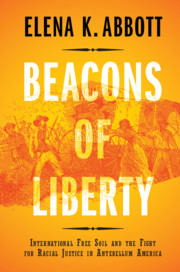Book contents
- Beacons of Liberty
- Beacons of Liberty
- Copyright page
- Contents
- List of Figures, Maps, and Tables
- Additional material
- Introduction
- Chapter 1 Reform and Relocation: West Africa and Haiti in the Early Republic
- Chapter 2 Exit and Expansion: The Search for Legal Equality in a Time of Crisis
- Chapter 3 Departure and Debate: Free Black Emigration to Canada and Mexico
- Chapter 4 Assessing Abolition: Investigating the Results of British Emancipation
- Chapter 5 Reputations and Expectations: Assessing Migrant Life in Upper Canada
- Chapter 6 Escape and Escalation: Self-Emancipation and the Geopolitics of Freedom
- Chapter 7 Free Soil, Fiction, and the Fugitive Slave Act
- Chapter 8 Emigration and Enmity: The Meaning of Free Soil in a Nation Divided
- Conclusion
- Acknowledgments
- Notes
- Bibliography
- Index
Chapter 6 - Escape and Escalation: Self-Emancipation and the Geopolitics of Freedom
Published online by Cambridge University Press: 09 April 2021
- Beacons of Liberty
- Beacons of Liberty
- Copyright page
- Contents
- List of Figures, Maps, and Tables
- Additional material
- Introduction
- Chapter 1 Reform and Relocation: West Africa and Haiti in the Early Republic
- Chapter 2 Exit and Expansion: The Search for Legal Equality in a Time of Crisis
- Chapter 3 Departure and Debate: Free Black Emigration to Canada and Mexico
- Chapter 4 Assessing Abolition: Investigating the Results of British Emancipation
- Chapter 5 Reputations and Expectations: Assessing Migrant Life in Upper Canada
- Chapter 6 Escape and Escalation: Self-Emancipation and the Geopolitics of Freedom
- Chapter 7 Free Soil, Fiction, and the Fugitive Slave Act
- Chapter 8 Emigration and Enmity: The Meaning of Free Soil in a Nation Divided
- Conclusion
- Acknowledgments
- Notes
- Bibliography
- Index
Summary
This chapter explores highly publicized episodes of international free-soil border crossing by land and by sea in the 1830s and 1840s. It was during these decades that the so-called Underground Railroad to Canada became a recognizable feature of the American anti-slavery landscape. Anti-slavery advocates publicly and volubly celebrated each instance of former slaves escaping the reach of slave-holders, and the publicity generated by border-crossing slaves inspired abolitionists to see Canada as a beacon of black freedom. Cumulatively, the successful escape of fugitive slaves to Canada, Mexico, and the British West Indies also catalyzed international diplomatic crises that permanently altered the geopolitical map of slavery and freedom. While millions remained enslaved during the antebellum era, the efforts of fugitive slaves to claim their freedom transformed international free-soil havens into powerful symbols of freedom and escape.
Keywords
- Type
- Chapter
- Information
- Beacons of LibertyInternational Free Soil and the Fight for Racial Justice in Antebellum America, pp. 149 - 172Publisher: Cambridge University PressPrint publication year: 2021

